2014 Tour de France Guide
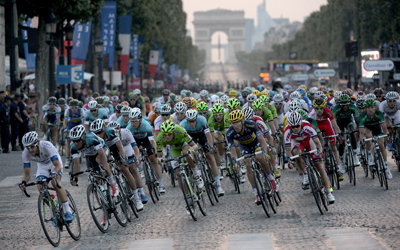 All July, worldwide attention turns to the most famous and exciting bicycle race on the planet, the Tour de France. This year's contest, edition 101, starts with 198 best-of-the-best professionals storming the asphalt of the opening road race in England, 288 miles from the French border.
All July, worldwide attention turns to the most famous and exciting bicycle race on the planet, the Tour de France. This year's contest, edition 101, starts with 198 best-of-the-best professionals storming the asphalt of the opening road race in England, 288 miles from the French border.
Thundering toward London two days later, they return to France via the Chunnel for Stage 4. To survive to the finish in Paris three weeks after they start (photo), the men will need extraordinary determination, perseverance and luck.
Years of preparation, discipline and experience—plus world-class talent—are required, simply to get on a team's Tour roster. When the starter's gun sounds on July 5, everyone in the bunch will face the toughest test of their career, whether it's their first Tour (Carlos Betancur) or their 17th (Jens Voigt)! When the Maillot Jaune is on the line, every pedal stroke counts.
Defending champion Chris Froome will be back, ready to repeat. But will his teammate, 2012 Tour winner Bradley Wiggins, join in as a super domestique, or will team brass force him to sit out his home country Grand Depart? Last year's Giro d'Italia Champion Vincenzo Nibali has built his entire year around the Tour, and in early season races Alberto Contador appears to be back to his Grand Tour-winning ways.
A total of 21 stages—covering 2,271 miles—await: 9 are flat, 5 are hilly, 6 are mountainous (with 5 of those having massive summit finishes!), just 1 is an individual time trial against the clock, and 2 extra rest days are also tossed in. This means the eventual winner will have to possess an unrivaled combination of TT power, climbing nous, tactical know-how and the ability and drive to steal seconds on seemingly benign transition stages.
To learn more about the overall contenders, this year's most important stages, fun Tour terms and more, we've prepared this handy guide. It will help you fully appreciate and enjoy the world's most spectacular sporting event.
| Crucial Stages |
 Stage 1 | Saturday, July 5 | Leeds to Harrogate (Great Britain) | Road Race: 190km / 118 miles. Mark Cavendish has won just about every race possible. He's a former World Champion on the road, he's won 25 stages of the Tour de France, and another 18 combined in the Giro d'Italia and Vuelta a España. One thing he hasn't done, however, is wear the coveted Maillot Jaune. This is his chance. The Grand Depart is in his home country of Great Britain, and the day actually finishes in his mother's hometown. Cavendish even publicly stated that the likely sprint in Harrogate "is what my whole season is built around." Just don't expect the other sprinters, like Marcel Kittel or Andre Greipel, to politely sit back and watch. They wouldn't feel too bad about spoiling Cav's storybook beginning to the 101st Tour de France and donning the Yellow Jersey themselves. Stage 1 | Saturday, July 5 | Leeds to Harrogate (Great Britain) | Road Race: 190km / 118 miles. Mark Cavendish has won just about every race possible. He's a former World Champion on the road, he's won 25 stages of the Tour de France, and another 18 combined in the Giro d'Italia and Vuelta a España. One thing he hasn't done, however, is wear the coveted Maillot Jaune. This is his chance. The Grand Depart is in his home country of Great Britain, and the day actually finishes in his mother's hometown. Cavendish even publicly stated that the likely sprint in Harrogate "is what my whole season is built around." Just don't expect the other sprinters, like Marcel Kittel or Andre Greipel, to politely sit back and watch. They wouldn't feel too bad about spoiling Cav's storybook beginning to the 101st Tour de France and donning the Yellow Jersey themselves. |
 Stage 2 | Sunday, July 6 | York to Sheffield (Great Britain) | Road Race: 201km / 125 miles. After a stage for the sprinters comes one for the Classics riders. If you were to take all nine categorized climbs that are on tap and combine them into one mountain, it'd be over 11 miles long at an average gradient of over 7%! Granted, the lumpy configuration of the course will give savvy racers plenty of time to rest in between the steep pitches, but all the GC men must be on high alert for what appears to be an unpredictable stage. Perhaps someone like Valverde—a punchy rider who thinks he'll be outclassed in week 3 on the highest switchbacks in the Alps—will attempt a daring maneuver to gain time, however small, on his rivals. Stage 2 | Sunday, July 6 | York to Sheffield (Great Britain) | Road Race: 201km / 125 miles. After a stage for the sprinters comes one for the Classics riders. If you were to take all nine categorized climbs that are on tap and combine them into one mountain, it'd be over 11 miles long at an average gradient of over 7%! Granted, the lumpy configuration of the course will give savvy racers plenty of time to rest in between the steep pitches, but all the GC men must be on high alert for what appears to be an unpredictable stage. Perhaps someone like Valverde—a punchy rider who thinks he'll be outclassed in week 3 on the highest switchbacks in the Alps—will attempt a daring maneuver to gain time, however small, on his rivals. |
 Stage 5 | Wednesday, July 9 | Ypres (Belgium) to Arenberg Porte du Hainaut | Cobbled Road Race: 155km / 96 miles. The Tour is steeped in history, and race organizers will honor the 100-year anniversary of the start of World War I with a route that takes off from the Belgian town of Ypres. The day's battle will roll over many of the same cobbled streets as the famous Paris-Roubaix. Nine pavé sections covering nearly 10 miles could be treacherous for the overall contenders, who often skip Roubaix, the Tour of Flanders, and other cobbled classics. It's not easy riding over jarring, century-old bricks. Add in a sprinkle of precipitation, and it could be even more dangerous. No one will win the Tour today, but carelessness or a simple moment's inattention could certainly end it for some. Stage 5 | Wednesday, July 9 | Ypres (Belgium) to Arenberg Porte du Hainaut | Cobbled Road Race: 155km / 96 miles. The Tour is steeped in history, and race organizers will honor the 100-year anniversary of the start of World War I with a route that takes off from the Belgian town of Ypres. The day's battle will roll over many of the same cobbled streets as the famous Paris-Roubaix. Nine pavé sections covering nearly 10 miles could be treacherous for the overall contenders, who often skip Roubaix, the Tour of Flanders, and other cobbled classics. It's not easy riding over jarring, century-old bricks. Add in a sprinkle of precipitation, and it could be even more dangerous. No one will win the Tour today, but carelessness or a simple moment's inattention could certainly end it for some. |
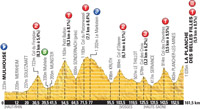 Stage 10 | Monday, July 14 | Mulhouse to La Planche des Belles Filles | Road Race: 161km / 100 miles. Small time gaps amongst the leaders just may become bigger after the seven massive climbs, including the penultimate Col de Chevrères followed immediately by the mountaintop finish of La Planche de Belles Filles. None of the climbs is insanely steep, nor extraordinarily long. But after the first 7 miles, there's hardly an inch of flat road. That relentlessness creates the difficulty. Up and down, up and down go the riders on this undulating parcours. So too, will various names on the leaderboard once they all cross the finish in utter exhaustion. Expect Chris Froome to display his dominance over the likes of Alberto Contador and others; if Froome wasn't in Yellow before today's stage, he'll likely take it with him on tomorrow's rest day. Stage 10 | Monday, July 14 | Mulhouse to La Planche des Belles Filles | Road Race: 161km / 100 miles. Small time gaps amongst the leaders just may become bigger after the seven massive climbs, including the penultimate Col de Chevrères followed immediately by the mountaintop finish of La Planche de Belles Filles. None of the climbs is insanely steep, nor extraordinarily long. But after the first 7 miles, there's hardly an inch of flat road. That relentlessness creates the difficulty. Up and down, up and down go the riders on this undulating parcours. So too, will various names on the leaderboard once they all cross the finish in utter exhaustion. Expect Chris Froome to display his dominance over the likes of Alberto Contador and others; if Froome wasn't in Yellow before today's stage, he'll likely take it with him on tomorrow's rest day. |
 Stage 11 | Wednesday, July 16 | Besançon to Oyonnax | Road Race: 187km / 116 miles. Several unremitting climbs in the final 35 miles of the stage make this one all about recovery. How well did riders recover after the mountainous Stage 10? Was the rest day beneficial, or did one of the leaders have to spend too much time fielding questions from the media and not enough time horizontal on a bed in their hotel? Once the race starts, riders high on GC will use the first 80 miles to stay out of the wind, spin their legs up to speed, and wait for the inevitable attacks. With a fast downhill after the peaceful Lac Genin, daring descenders could try for a bold, late-stage bid for victory. Will someone like Peter Sagan walk away with the win, or could we see the often-futile breakaway finally succeed? Stage 11 | Wednesday, July 16 | Besançon to Oyonnax | Road Race: 187km / 116 miles. Several unremitting climbs in the final 35 miles of the stage make this one all about recovery. How well did riders recover after the mountainous Stage 10? Was the rest day beneficial, or did one of the leaders have to spend too much time fielding questions from the media and not enough time horizontal on a bed in their hotel? Once the race starts, riders high on GC will use the first 80 miles to stay out of the wind, spin their legs up to speed, and wait for the inevitable attacks. With a fast downhill after the peaceful Lac Genin, daring descenders could try for a bold, late-stage bid for victory. Will someone like Peter Sagan walk away with the win, or could we see the often-futile breakaway finally succeed? |
 Stage 13 | Friday, July 18 | Saint-Étienne to Chamrousse | Road Race: 197km / 122 miles. It doesn't look like much on paper, but it has the power to catch any one of the favorites off-guard. After a brief climb up the Col de la Croix de Montvieux, the peloton will descend into the Rhône Valley for 60 miles of flat roads and wine daydreams. But before they know it, the Alps come calling, and the bunch will be facing down the new-to-the-Tour Col de Palaquit before slogging up the 11-mile Montée de Chamrousse finish. Plan to see the GC favorites trading blows on their way to the top. Stage 13 | Friday, July 18 | Saint-Étienne to Chamrousse | Road Race: 197km / 122 miles. It doesn't look like much on paper, but it has the power to catch any one of the favorites off-guard. After a brief climb up the Col de la Croix de Montvieux, the peloton will descend into the Rhône Valley for 60 miles of flat roads and wine daydreams. But before they know it, the Alps come calling, and the bunch will be facing down the new-to-the-Tour Col de Palaquit before slogging up the 11-mile Montée de Chamrousse finish. Plan to see the GC favorites trading blows on their way to the top. |
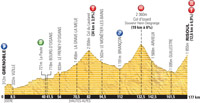 Stage 14 | Saturday, July 19 | Grenoble to Risoul | Road Race: 177km / 110 miles. Once again, recovery is the name of the game. With yesterday's mountaintop finish still fresh in their minds and muscles, those still in the race will face an onslaught of ascension on their way to the ski resort of Risoul. The Col de Lauteret is first up. What it lacks in steepness it makes up for in distance: it averages less than 4%, but it drags on for a lung-scorching 21 miles. Softened legs will then head up the Col d'Izoard, the highest point of the Tour at an elevation of 7,742 feet and an hors catégorie ascent. A grueling 12 miles at an average gradient of 6% just might be the springboard for an opportunist who doesn't pose a threat to the Yellow Jersey. You'll likely see the GC leaders play it conservatively until they hit the last climb of the day to Risoul. This is the kind of stage that sprinters have nightmares about. Stage 14 | Saturday, July 19 | Grenoble to Risoul | Road Race: 177km / 110 miles. Once again, recovery is the name of the game. With yesterday's mountaintop finish still fresh in their minds and muscles, those still in the race will face an onslaught of ascension on their way to the ski resort of Risoul. The Col de Lauteret is first up. What it lacks in steepness it makes up for in distance: it averages less than 4%, but it drags on for a lung-scorching 21 miles. Softened legs will then head up the Col d'Izoard, the highest point of the Tour at an elevation of 7,742 feet and an hors catégorie ascent. A grueling 12 miles at an average gradient of 6% just might be the springboard for an opportunist who doesn't pose a threat to the Yellow Jersey. You'll likely see the GC leaders play it conservatively until they hit the last climb of the day to Risoul. This is the kind of stage that sprinters have nightmares about. |
 Stage 16 | Tuesday, July 22 | Carcassonne to Bagnères-de-Luchon | Road Race: 237km / 147 miles. The longest stage of the Tour comes after the second rest day. Its main feature is the brutal Port de Balès climb, but this isn't your straightforward mountaintop finish. Instead, riders must suffer to the top, then immediately point their noses downward to negotiate a fast, precarious descent that drops nearly 3,700 vertical feet in 13 miles. The final 1.5 miles are pancake flat, but don't expect a huge group to come to the line together. Depending on where he is on the leaderboard, Vincenzo Nibali might try to attack on the downhill and put some distance between himself and the likes of Froome and Contador. Stage 16 | Tuesday, July 22 | Carcassonne to Bagnères-de-Luchon | Road Race: 237km / 147 miles. The longest stage of the Tour comes after the second rest day. Its main feature is the brutal Port de Balès climb, but this isn't your straightforward mountaintop finish. Instead, riders must suffer to the top, then immediately point their noses downward to negotiate a fast, precarious descent that drops nearly 3,700 vertical feet in 13 miles. The final 1.5 miles are pancake flat, but don't expect a huge group to come to the line together. Depending on where he is on the leaderboard, Vincenzo Nibali might try to attack on the downhill and put some distance between himself and the likes of Froome and Contador. |
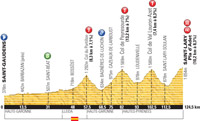 Stage 17 | Wednesday, July 23 | Saint-Gaudens to Saint-Lary-Soulan | Road Race: 124km / 77 miles. Immediately following the longest day is the Tour's shortest, aside from the time trial. The race briefly crosses over into Spain, where the Col du Portillon—the first of four mountains in the Pyrenees—beckons. Then comes the Col de Peyresourde, first used in the 1910 Tour. Next is the Col de Val Louron-Azet, and finally, the mountaintop finish at Pla d'Adet. There could be three races going on simultaneously during this stage: first, the riders in the likely breakaway will be fighting for stage glory; second, a bit farther back, the GC contenders will duke it out amongst themselves for a chance at the Yellow Jersey; and third, at the very back of the race, sprinters in the grupetto will be going all out in the simple hope of making it to the finish within the time cut. This could be the most dynamic and exciting stage of the Tour. Stage 17 | Wednesday, July 23 | Saint-Gaudens to Saint-Lary-Soulan | Road Race: 124km / 77 miles. Immediately following the longest day is the Tour's shortest, aside from the time trial. The race briefly crosses over into Spain, where the Col du Portillon—the first of four mountains in the Pyrenees—beckons. Then comes the Col de Peyresourde, first used in the 1910 Tour. Next is the Col de Val Louron-Azet, and finally, the mountaintop finish at Pla d'Adet. There could be three races going on simultaneously during this stage: first, the riders in the likely breakaway will be fighting for stage glory; second, a bit farther back, the GC contenders will duke it out amongst themselves for a chance at the Yellow Jersey; and third, at the very back of the race, sprinters in the grupetto will be going all out in the simple hope of making it to the finish within the time cut. This could be the most dynamic and exciting stage of the Tour. |
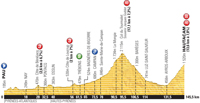 Stage 18 | Thursday, July 24 | Pau to Hautacam | Road Race: 145km / 90 miles. This is the last chance for climbers in the top 10 like Alejandro Valverde or even Jürgen Van Den Broeck—they'll likely lose a bit of time in the Stage 20 time trial—to give it one final go in the mountains. The Maillot Jaune will play it cautiously, simply marking his nearest rivals and allowing anyone several minutes down to ride away on the Col du Tourmalet. Once the bunch descends and begins the climb up to the alpine finish at Hautacam, however, all bets are off. At that point, the cream will rise to the top. We'll likely see Contador and Froome chasing the remnants of the breakaway, one of them cementing his lead ahead of the TT in two days' time. Stage 18 | Thursday, July 24 | Pau to Hautacam | Road Race: 145km / 90 miles. This is the last chance for climbers in the top 10 like Alejandro Valverde or even Jürgen Van Den Broeck—they'll likely lose a bit of time in the Stage 20 time trial—to give it one final go in the mountains. The Maillot Jaune will play it cautiously, simply marking his nearest rivals and allowing anyone several minutes down to ride away on the Col du Tourmalet. Once the bunch descends and begins the climb up to the alpine finish at Hautacam, however, all bets are off. At that point, the cream will rise to the top. We'll likely see Contador and Froome chasing the remnants of the breakaway, one of them cementing his lead ahead of the TT in two days' time. |
 Stage 20 | Saturday, July 26 | Bergerac to Périgueux | Time Trial: 54km / 33 miles. Any lingering GC questions will be answered during the one and only time trial in this year's Tour de France. It's a tough, lumpy course, and it's long enough that major time gaps could open up among the favorites. Fabian Cancellara had one of the most amazing classics seasons in 2013, but decided to skip last year's 100th edition. Now the man who's won 7 career TT stages in the Tour (and has worn Yellow in 5 separate years) is back and hungry for another win. It's a bit unfortunate, though, that his duel with three-time defending World Time Trial Champion Tony Martin for the day's honors will likely be upstaged by the GC rider who secures the Maillot Jaune for the ceremonial ride into Paris the next day. Stage 20 | Saturday, July 26 | Bergerac to Périgueux | Time Trial: 54km / 33 miles. Any lingering GC questions will be answered during the one and only time trial in this year's Tour de France. It's a tough, lumpy course, and it's long enough that major time gaps could open up among the favorites. Fabian Cancellara had one of the most amazing classics seasons in 2013, but decided to skip last year's 100th edition. Now the man who's won 7 career TT stages in the Tour (and has worn Yellow in 5 separate years) is back and hungry for another win. It's a bit unfortunate, though, that his duel with three-time defending World Time Trial Champion Tony Martin for the day's honors will likely be upstaged by the GC rider who secures the Maillot Jaune for the ceremonial ride into Paris the next day. |
| The Stars |
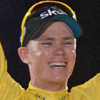 Chris Froome (Sky): The defending Tour de France Champion is on a different level than the rest of the peloton. Just like in the run-up to last year's Tour, he's again won the overall in the Tour of Oman and Tour de Romandie. Additionally, he now has the experience of winning a Grand Tour, knowledge that's sure to help him during crunch time in July. Strong in the mountains, strong in the time trials, and with the backing of Team Sky, Froome doesn't appear to have any chinks in his armor, unless you count an untimely crash in the Critérium du Dauphiné, which kept him out of the top 10. If he can avoid the inevitable Week 1 crashes (see Stage 5), we should see Froome on the podium in Paris. But will he again be on the highest step? Chris Froome (Sky): The defending Tour de France Champion is on a different level than the rest of the peloton. Just like in the run-up to last year's Tour, he's again won the overall in the Tour of Oman and Tour de Romandie. Additionally, he now has the experience of winning a Grand Tour, knowledge that's sure to help him during crunch time in July. Strong in the mountains, strong in the time trials, and with the backing of Team Sky, Froome doesn't appear to have any chinks in his armor, unless you count an untimely crash in the Critérium du Dauphiné, which kept him out of the top 10. If he can avoid the inevitable Week 1 crashes (see Stage 5), we should see Froome on the podium in Paris. But will he again be on the highest step? |
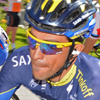 Alberto Contador (Saxo-Tinkoff): Since returning from his backdated doping ban in February 2012, Contador has shown glimpses of the dominance that led him to win three Tours de France (one later annulled), two Giri d'Italia, and one Vuelta a España. He added a second Vuelta win at the tail end of 2012, but in 2013 El Pistolero was one notch below his competitors, and his former self. This year appears to be vintage Contador. He won two stages and the overall of Tirreno-Adriatico, one stage and the overall of the Tour of the Basque Country, and was second in the Criterium du Dauphine. We don't know how far up the GC ladder he'll finish, but one thing is certain: his attacking style will ensure the 2014 Tour is an exciting one! Alberto Contador (Saxo-Tinkoff): Since returning from his backdated doping ban in February 2012, Contador has shown glimpses of the dominance that led him to win three Tours de France (one later annulled), two Giri d'Italia, and one Vuelta a España. He added a second Vuelta win at the tail end of 2012, but in 2013 El Pistolero was one notch below his competitors, and his former self. This year appears to be vintage Contador. He won two stages and the overall of Tirreno-Adriatico, one stage and the overall of the Tour of the Basque Country, and was second in the Criterium du Dauphine. We don't know how far up the GC ladder he'll finish, but one thing is certain: his attacking style will ensure the 2014 Tour is an exciting one! |
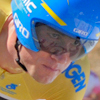 Tejay van Garderen (BMC): Which van Garderen will we see in July? The one who rode to 5th place in the 2012 Tour de France, despite racing in support of his team leader? The same one who rode to victories in the two biggest American races in 2013, the USA Pro Cycling Challenge and the Tour of California? Or will we see the one who finished 45th in the 2013 Tour, over 90 minutes down, and finished a lackluster 13th at this year's Dauphiné? He's shown glimmers of hope, but can he finally string three weeks' worth of consistent riding and vie for a podium spot in Paris? For the first time, van Garderen has the full support of his BMC team, so he need not worry about in-team rivalry and politics. That could be freeing enough to let van Garderen fly in July. Tejay van Garderen (BMC): Which van Garderen will we see in July? The one who rode to 5th place in the 2012 Tour de France, despite racing in support of his team leader? The same one who rode to victories in the two biggest American races in 2013, the USA Pro Cycling Challenge and the Tour of California? Or will we see the one who finished 45th in the 2013 Tour, over 90 minutes down, and finished a lackluster 13th at this year's Dauphiné? He's shown glimmers of hope, but can he finally string three weeks' worth of consistent riding and vie for a podium spot in Paris? For the first time, van Garderen has the full support of his BMC team, so he need not worry about in-team rivalry and politics. That could be freeing enough to let van Garderen fly in July. |
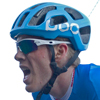 Andrew Talansky (Garmin-Sharp): This could be another breakthrough year for the young American. He climbs among the best in the world, he TTs exceptionally well, and his Garmin-Sharp team is strong and full of Tour experience. They're also not afraid to take risks and make gutsy tactical maneuvers to try to catch opponents off-guard, in stark contrast to Team Sky's metronomic racing. Talansky's youthful exuberance is a double-edged sword: the same quality that keeps him fearless may also hinder him from keeping calm, as it did in the 2013 Paris-Nice, where he didn't gauge his efforts well enough and lost the leader's jersey on the tough queen stage. After finishing 10th in last year's Tour, a top 5 is definitely in reach. His incredible come-from-behind overall win in this year's Dauphiné showed he's ready for prime time. Andrew Talansky (Garmin-Sharp): This could be another breakthrough year for the young American. He climbs among the best in the world, he TTs exceptionally well, and his Garmin-Sharp team is strong and full of Tour experience. They're also not afraid to take risks and make gutsy tactical maneuvers to try to catch opponents off-guard, in stark contrast to Team Sky's metronomic racing. Talansky's youthful exuberance is a double-edged sword: the same quality that keeps him fearless may also hinder him from keeping calm, as it did in the 2013 Paris-Nice, where he didn't gauge his efforts well enough and lost the leader's jersey on the tough queen stage. After finishing 10th in last year's Tour, a top 5 is definitely in reach. His incredible come-from-behind overall win in this year's Dauphiné showed he's ready for prime time. |
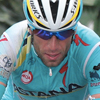 Vincenzo Nibali (Astana): Nibali's record is quite remarkable. Since 2010, he's raced 7 Grand Tours, and finished on the podium in 6 of those. The last time he rode the Tour, in 2012, he finished 3rd. Last year, he won the Giro d'Italia, Tirreno-Adriatico, and the Giro del Trentino, and he finished 2nd in the Vuelta a España to American Chris Horner. This year, however, he's been consistently near the front, but is without a single victory. Will the "Shark of Messina" have enough bite in France to challenge Froome and Contador? Or will he quietly swim his way into top 10 contention, without making a big splash? Vincenzo Nibali (Astana): Nibali's record is quite remarkable. Since 2010, he's raced 7 Grand Tours, and finished on the podium in 6 of those. The last time he rode the Tour, in 2012, he finished 3rd. Last year, he won the Giro d'Italia, Tirreno-Adriatico, and the Giro del Trentino, and he finished 2nd in the Vuelta a España to American Chris Horner. This year, however, he's been consistently near the front, but is without a single victory. Will the "Shark of Messina" have enough bite in France to challenge Froome and Contador? Or will he quietly swim his way into top 10 contention, without making a big splash? |
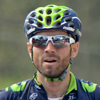 Alejandro Valverde (Movistar): The veteran Spaniard is amazingly measured in his efforts, only attacking when he knows he can snag a few seconds here or there. Otherwise, in the high mountains he often follows and in the time trials he simply limits his losses. He also knows how to win. Already this year, he's taken victories in the Fleche Wallonne, Roma Maxima, GP Miguel Indurain, the Vuelta a Murcia, and the Vuelta a Andalucia. Add to that a 2nd at Liege-Bastogne-Liege, a 3rd at Strade Bianche, and a 4th at Amstel Gold, and it's no surprise that Valverde is being talked about as a dark horse for the Paris Podium. If there's an opportunity for him to grab the race by the horns, expect him to take it. Alejandro Valverde (Movistar): The veteran Spaniard is amazingly measured in his efforts, only attacking when he knows he can snag a few seconds here or there. Otherwise, in the high mountains he often follows and in the time trials he simply limits his losses. He also knows how to win. Already this year, he's taken victories in the Fleche Wallonne, Roma Maxima, GP Miguel Indurain, the Vuelta a Murcia, and the Vuelta a Andalucia. Add to that a 2nd at Liege-Bastogne-Liege, a 3rd at Strade Bianche, and a 4th at Amstel Gold, and it's no surprise that Valverde is being talked about as a dark horse for the Paris Podium. If there's an opportunity for him to grab the race by the horns, expect him to take it. |
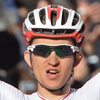 Michal Kwiatkowski (Omega Pharma-Quick Step): The young Pole will be a contender for the White Jersey, but likely has bigger plans that that. He tore through the early season races this year, winning Strade Bianche, two stages and the overall of the Volta ao Algarve, the prologue of the Tour de Romandie, as well as a consistent 3rd in Fleche Wallonne, 3rd in Liege-Bastogne-Liege, and 5th in Amstel Gold. His team will primarily be gunning for sprinter Mark Cavendish, so the "Flowerman" won't have the full backing of his team. The main question will be how he handles the mountains in the final week of the race. Michal Kwiatkowski (Omega Pharma-Quick Step): The young Pole will be a contender for the White Jersey, but likely has bigger plans that that. He tore through the early season races this year, winning Strade Bianche, two stages and the overall of the Volta ao Algarve, the prologue of the Tour de Romandie, as well as a consistent 3rd in Fleche Wallonne, 3rd in Liege-Bastogne-Liege, and 5th in Amstel Gold. His team will primarily be gunning for sprinter Mark Cavendish, so the "Flowerman" won't have the full backing of his team. The main question will be how he handles the mountains in the final week of the race. |
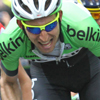 Bauke Mollema (Belkin): Mollema turned heads last year en route to a 6th place finish at the Tour. With only a few notable results in 2014—4th at Fleche Wallonne, 7th at Amstel Gold, and a stage win at the second-tier Tour of Norway—many wonder whether he'll return to his form from last year. Knowing he has fellow Dutchman Laurens Ten Dam at his side will give him some reassurance as he attempts to crack the top 5. There's nothing flashy about Mollema's all-around riding style, but oftentimes the Tour rewards consistency above all else. He might not be on the front, and he might not be making the race, but he'll be among the favorites when the road turns up. Bauke Mollema (Belkin): Mollema turned heads last year en route to a 6th place finish at the Tour. With only a few notable results in 2014—4th at Fleche Wallonne, 7th at Amstel Gold, and a stage win at the second-tier Tour of Norway—many wonder whether he'll return to his form from last year. Knowing he has fellow Dutchman Laurens Ten Dam at his side will give him some reassurance as he attempts to crack the top 5. There's nothing flashy about Mollema's all-around riding style, but oftentimes the Tour rewards consistency above all else. He might not be on the front, and he might not be making the race, but he'll be among the favorites when the road turns up. |
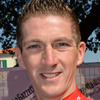 Jürgen Van Den Broeck (Lotto-Belisol): Getting 4th in the Tour de France, as Van Den Broeck did in 2010, is no small feat. Repeating the result two years later is even more remarkable. He was 7th in the 2008 Giro and 8th in the 2011 Vuelta, so he clearly knows how to get a top 10 in a Grand Tour. He finished 3rd in this year's Dauphiné, so he proved he can climb with the best, and also that he is on form. Consistently in contention, can the 31-year-old string it all together and finally break through to the next level that Belgian media and spectators have come to expect of him? A knock on his team is that several of the riders will be looking after André Greipel in the sprints, so he may have to freelance a bit when the going gets steep. Jürgen Van Den Broeck (Lotto-Belisol): Getting 4th in the Tour de France, as Van Den Broeck did in 2010, is no small feat. Repeating the result two years later is even more remarkable. He was 7th in the 2008 Giro and 8th in the 2011 Vuelta, so he clearly knows how to get a top 10 in a Grand Tour. He finished 3rd in this year's Dauphiné, so he proved he can climb with the best, and also that he is on form. Consistently in contention, can the 31-year-old string it all together and finally break through to the next level that Belgian media and spectators have come to expect of him? A knock on his team is that several of the riders will be looking after André Greipel in the sprints, so he may have to freelance a bit when the going gets steep. |
|
Other riders to watch: Rui Costa (Lampre-Merida) is the reigning World Road Race Champion. He's never factored in the overall, but the man who was 2nd at this year's Paris-Nice, riding for a new team, knows a thing or three about winning Tour stages, taking one in 2011 and two more last year. For the first time, he'll enter with an eye toward the overall. Whether the former stage-hunter can stack up after three hard weeks, however, remains to be seen. Europcar's Thomas Voeckler is another fan favorite. Though he was held winless last year, the 4-time stage winner will most definitely see the front of the race. His attacks are not unlike those of Katusha's Joaquim Rodriguez, a rider who was slated to skip the Tour, but crashed during the Giro d'Italia and now looks to at least vie for a stage win in July. And, there is one man who won't be in the GC hunt but should nevertheless be mentioned: Tony Martin. He will enter the Tour knowing that the Stage 20 time trial is his to lose; he'll simply have to ride 2000 miles over the first 19 days to get a chance for the stage victory! The sprinters: This year's Tour will also feature plenty of opportunities for the sprinters to shine. After an incredible four stage victories last year, all eyes will be on Marcel Kittel if he's anywhere near the leaders at the finish line. The big German showed last year that there's a new sprinter in town. If Kittel plans to win, however, he'll have to be faster than Mark Cavendish, and that's no easy feat. Especially considering Cav's never worn Yellow and the first stage finishes near his mother's hometown in Great Britain. During last year's Tour, the "Manx Missile" lacked the extra 1% that normally propels him to 4 or 5 stage wins per Tour. He was only able to win once. Expect to see him back to his old ways in the epic duels of the early flat stages. 2012's Green Jersey runner-up André "The Gorilla" Greipel will be looking to get back to the form that brought him three stage wins in that year's Tour. In 2011 and again last year, he only managed one stage. Will he be able to consistently mix it up at the front of the big bunch sprints again this year? |
Tour Terms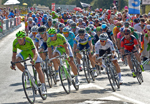 Peloton: The main body or group of riders. Also called the "pack," "field" and "group."
Peloton: The main body or group of riders. Also called the "pack," "field" and "group."
Stage: One of the individual daily races that make up the Tour. This year's event is composed of 21 days of racing (two individual time trials, one team time trial, and 18 road stages).
Individual Time Trial (also called "the race of truth" and "the race against the clock"): A special event where riders cover a set course alone. Every rider's time is recorded and then compared to determine who went the fastest. Time trials often play a major role in determining the overall race winner because the strongest riders go the fastest and gain time on those who don't have the horsepower to maintain top speed without the support of their team. Be on the lookout for the most expensive, aerodynamic, futuristic-looking wheels, helmets, and handlebars in this event.
General Classification (GC): This is the term used in stage racing for the current overall rider standings. Since stage races are comprised of multiple races, there are results for each race and also results for each rider's cumulative time for all stages. The person with the lowest time overall after all the races is first on GC and the winner of the race.
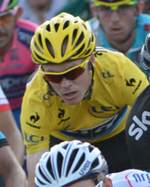 Maillot Jaune: The Yellow Jersey (left) is worn by the current race leader (see: General Classification). It is also a term used to refer to the leader. TV commentators might say, "The Yellow Jersey is flying today." The Yellow Jersey was created by Tour founder Henri Desgranges in 1913 to ensure the lead rider could be easily recognized by spectators. He chose yellow to honor a race sponsor, L'Equipe newspaper, who printed their pages on yellow paper. Interestingly, L'Equipe is still a major Tour sponsor and continues to use yellow paper.
Maillot Jaune: The Yellow Jersey (left) is worn by the current race leader (see: General Classification). It is also a term used to refer to the leader. TV commentators might say, "The Yellow Jersey is flying today." The Yellow Jersey was created by Tour founder Henri Desgranges in 1913 to ensure the lead rider could be easily recognized by spectators. He chose yellow to honor a race sponsor, L'Equipe newspaper, who printed their pages on yellow paper. Interestingly, L'Equipe is still a major Tour sponsor and continues to use yellow paper.
Maillot Vert: The Green Jersey is worn by the leader in the points or sprinter's competition. Each stage has two to four intermediate sprints placed along the day's course. Points are awarded for the first three riders across the line at these sprints, and also for the top finishers at day's end. This jersey is highly sought after among the race's fastmen who battle for top placements during the flat stages. And unlike the other grand tours, the Tour awards more points at the finish of flat stages than hilly ones to prevent an overall contender from overshadowing the sprinters.
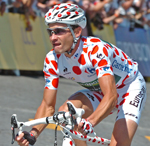 Maillot À Pois: The Polka Dot Jersey (right) is worn by the best climber in the King of the Mountains competition. Points are awarded at the top of designated climbs. As the climbs get tougher and correspondingly higher in ranking, more points are awarded.
Maillot À Pois: The Polka Dot Jersey (right) is worn by the best climber in the King of the Mountains competition. Points are awarded at the top of designated climbs. As the climbs get tougher and correspondingly higher in ranking, more points are awarded.
Maillot Blanc: The White Jersey is worn by the leading rider who is under 26 years old. Sometimes these young talents go on to wear the Maillot Jaune in future editions of the Tour.
Rider Type: The size and shape of a rider often determines his racing specialty. Sprinters tend to be taller with ham-size legs ready to crush the pedals in a frenzy of speed. Climbers can be quite short, and all are rail thin for maximum anti-gravity advantage. All-around riders, the ones capable of winning the Tour, tend to be of average height and weight, and are blessed with the ability to climb, time trial and sprint at a very high level day in and day out.
 Drafting: To ride so closely behind one or more fellow racers (left) that you are shielded from the wind, thereby saving considerable energy. The drafting effect increases as the size of a group grows, creating the potential for a number of riders to travel much faster than an individual cyclist (See: Paceline).
Drafting: To ride so closely behind one or more fellow racers (left) that you are shielded from the wind, thereby saving considerable energy. The drafting effect increases as the size of a group grows, creating the potential for a number of riders to travel much faster than an individual cyclist (See: Paceline).
Attack: One of the more spectacular scenes in cycling is a lone rider, head down giving it their all to blast off the front of the field. These impressive leg-searing efforts are what makes bike racing so thrilling to watch. Nothing beats a high-speed chess match and sometimes a well-timed attack is exactly what a rider needs to speed to victory or get in the day's big breakaway.
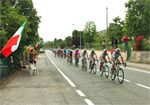 Paceline: A formation of racers riding in a single-file line. Each racer spends some time riding at the front pushing the wind for those behind him. Sharing the workload allows a group to go faster than one rider on his own. (See: Drafting.)
Paceline: A formation of racers riding in a single-file line. Each racer spends some time riding at the front pushing the wind for those behind him. Sharing the workload allows a group to go faster than one rider on his own. (See: Drafting.)
Echelon: When a small group of racers forms a diagonal line across the road while riding into an oncoming side wind to best take advantage of the drafting potential. (See: Drafting.)
 Breakaway: To ride away from the peloton in an effort to win a race. Because the peloton can ride much faster than an individual (see: Drafting and Paceline), breaking away is often a futile effort that usually leads to exhaustion with the peloton eventually catching and passing the hapless rider. However, sometimes the brazen attack pays off and the rider captures a dramatic win that can make his career.
Breakaway: To ride away from the peloton in an effort to win a race. Because the peloton can ride much faster than an individual (see: Drafting and Paceline), breaking away is often a futile effort that usually leads to exhaustion with the peloton eventually catching and passing the hapless rider. However, sometimes the brazen attack pays off and the rider captures a dramatic win that can make his career.
Sprint: The final, crazed charge for the finish line at the end of a race. Top sprinters attempting to out accelerate their opponents can reach speeds over 40mph. The finishing chaos and speed often cause spectacular crashes.
 Climb categories: Climbs are ranked on a scale of 1 to 4, with Category 1 being the most severe. However, there are climbs in the Tour that are so demanding they exceed this numerical ranking system. These "beyond category" climbs are referred to as Hors Catégorie (HC). Their extreme difficulty makes them some of the biggest factors when considering race strategy, as it's possible for a rider to gain minutes over a weaker rival. The tension and excitement around HC climbs also means the stages that feature them can be the most action packed of the whole Tour.
Climb categories: Climbs are ranked on a scale of 1 to 4, with Category 1 being the most severe. However, there are climbs in the Tour that are so demanding they exceed this numerical ranking system. These "beyond category" climbs are referred to as Hors Catégorie (HC). Their extreme difficulty makes them some of the biggest factors when considering race strategy, as it's possible for a rider to gain minutes over a weaker rival. The tension and excitement around HC climbs also means the stages that feature them can be the most action packed of the whole Tour.
 Descent: The tight, twisty mountain passes of Europe are notorious for rewarding world-class descenders and punishing those with less than superhuman bike-handling skills. It is common for descents to have upwards of 20 switchbacks in addition to other sharp curves that can make the difference between a race-winning effort and being reabsorbed by the pack. Some cyclists like Samuel Sanchez and Vincenzo Nibali wisely use descents to conserve energy and gain time over their rivals.
Descent: The tight, twisty mountain passes of Europe are notorious for rewarding world-class descenders and punishing those with less than superhuman bike-handling skills. It is common for descents to have upwards of 20 switchbacks in addition to other sharp curves that can make the difference between a race-winning effort and being reabsorbed by the pack. Some cyclists like Samuel Sanchez and Vincenzo Nibali wisely use descents to conserve energy and gain time over their rivals.
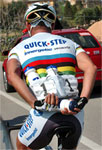 Domestique (Gregario): A racer who sacrifices his own chance of victory to help a teammate win. Tasks of these unsung heroes may include: carrying extra bottles and food for fellow riders, chasing breakaway groups, and even giving their bikes to the designated team leader should he have a mechanical problem. Simply put, domestiques do whatever is necessary to help their teammates win.
Domestique (Gregario): A racer who sacrifices his own chance of victory to help a teammate win. Tasks of these unsung heroes may include: carrying extra bottles and food for fellow riders, chasing breakaway groups, and even giving their bikes to the designated team leader should he have a mechanical problem. Simply put, domestiques do whatever is necessary to help their teammates win.
Equipment: Every rider has at least three bikes to choose from for any day of racing. A super-light rig for mountain stages, a deluxe aerodynamic machine for time trials, and a standard road bike for average racing days. Now, consider that every team uses at least 100 wheels and it's no wonder that a full-size bus is used for team and equipment transportation.
 Directeur Sportif (Sport Director): The person responsible for coaching riders and managing almost all logistical concerns of the team. During a race, the Directeur Sportif drives behind the peloton watching live race coverage on a dashboard-mounted TV and informs his team on proper race strategy. He may also pass out drinks and help with medical or mechanical issues.
Directeur Sportif (Sport Director): The person responsible for coaching riders and managing almost all logistical concerns of the team. During a race, the Directeur Sportif drives behind the peloton watching live race coverage on a dashboard-mounted TV and informs his team on proper race strategy. He may also pass out drinks and help with medical or mechanical issues.
Auto Bus (Grupetto): This term refers to the large group of riders that band together on difficult mountain stages and simply try to finish the day while conserving as much energy as possible. After all, they are going to need it during the next grueling stage.
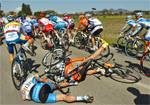 Crash: To fall off your bike and go "boom." As soon as a rider hits the deck, he is expected to remount and start racing again. Having a seriously broken bone is one of the very few things that will keep these tough men from continuing.
Crash: To fall off your bike and go "boom." As soon as a rider hits the deck, he is expected to remount and start racing again. Having a seriously broken bone is one of the very few things that will keep these tough men from continuing.
Time Limit (Time Cut): A way to eliminate the slowest riders in the race. After every stage a time cut is established by taking the winner's time and adding 10 to 20%. Riders who finish in excess of this buffer zone are not allowed to start the next day.
Caravan: A motorized circus composed of officials' vehicles, motorcycle police, team cars, medical vans, and photographers hanging precariously off the back of even more motorcycles.
Tour FAQ
How is the overall race winner determined?
Cumulative times are kept for all 21 stages. After the finish of the last stage, the rider who covered the whole trip around France in the least amount of time wins.
 It seems like a lot of the time, racers are rolling along in one big group. How do riders gain and lose time against one another?
It seems like a lot of the time, racers are rolling along in one big group. How do riders gain and lose time against one another?
During this multi-day race, it's quite difficult for race favorites to gain or lose time against each other while on flat or rolling terrain, as drafting and teamwork cancel out individual rider strength differences. Therefore, the mountainous climbing stages and time trials have a heavy impact on deciding who the final winner will be, as both require a competitor to ride on his own, without the benefit of drafting or help from his team.
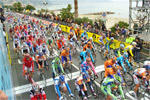 How can 198 guys race all day and then be awarded the same time at the finish?
How can 198 guys race all day and then be awarded the same time at the finish?
When a large group of riders, possibly the entire field, comes to the finish in one huge group, everyone is awarded the finishing time of the first rider to cross the line. This is done to prevent the final sprint from becoming exceedingly chaotic. Therefore, the sprinting madmen get to battle over the stage win while everyone else rides in safely just behind them, knowing they will not be penalized for their caution.
If one or two guys can ride ahead of the peloton and win a stage, why doesn't this happen every day? And, why does the peloton allow riders to pedal away and gain a few minutes of advantage?
The Tour de France is an incredibly demanding event and conserving energy is an important aspect of team strategy. With conservation in mind, the peloton will allow an individual rider or small group of riders a time advantage, betting the escapees will burn out, slow down, and be reabsorbed by the pack. (The pack will also speed up to catch escaped riders as the finish nears.) Letting riders build up an advantage is a calculated risk made by the teams without riders in the breakaway group. Sometimes, the pack's gamble backfires and the breakaway group stays away until the finish to contest the win among themselves.
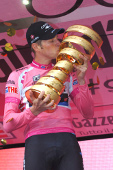 How can a racer win the Tour de France, but not win a single Stage?
How can a racer win the Tour de France, but not win a single Stage?
This scenario is possible but rarely happens. However, because the Tour leader board is organized by total overall time, the most consistent racer wins. For example, always finishing with the first few riders during every crucial stage (but not winning) will result in a very low overall accumulated time. In contrast, using up loads of energy trying to win a stage may result in a one-day victory, but the winning racer will usually pay for his energy output the next day, as exhaustion will more than likely cause him to finish near the back of the pack. Racers have a choice. Ride steadily near the front of the race, never using up too much energy in the hopes of winning the whole Tour. Or go all out attempting to win a stage, knowing full well they'll be exhausted the next day and overall victory will be impossible.
 The Tour de France is just an endurance event, right?
The Tour de France is just an endurance event, right?
Yes, grand tour racing requires an extreme amount of endurance, but it's far more complex than that. The Tour, and pro road racing in general, requires massive amounts of muscular strength to keep up with the many intense accelerations during the race. The most obvious examples are the finishing sprints and attacks at the front of the peloton. These intense bursts regularly require riders to sprint in a big gear, similar to doing weightlifting squats of twice their body weight as fast as they can for 10 seconds to a minute.
When you consider that riders put in these efforts from 10 to 30 times each stage just to stay within the peloton, you begin to understand what a Herculean effort is involved. What's more, these muscular efforts create micro-tears in the muscles, which can only be cured by proper nutrition and rest, two things cyclists can't get enough of at the Tour. So, not only are the world's best cyclists in the top percentile of endurance aces, but they are also muscular athletes gifted with the ability to sprint day-in and day-out up mountains and across the flats. In bike racing, it's rarely the strongest who wins, but rather it's the rider who can make different types of max efforts and still arrive at the finish fresher than the others.
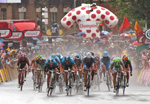 I know what the Green Jersey is, but how do they win it?
I know what the Green Jersey is, but how do they win it?
Unlike the exciting race for the Maillot Jaune, the points competition is a little bit more complicated than just cumulative time. On all the road stages, riders have 2 chances to score points that go toward their overall tally. These come in the form of one intermediate sprint roughly halfway through the stage and the finishing sprint. Points go 15 places deep in both, with the finish of course having more points up for grabs. At the stage finish, a maximum of 45 goes to the winner, depending on the stage type. Flat stages are worth the most and hilly, mountain and time trial days are worth less. This makes the Tour's points competition truly a race for the sprinters as it prevents the overall contenders from gobbling up all the points on days the fastmen can't compete.
Another interesting tidbit is how hard the fight for the Maillot Vert truly is. Even on rolling stages, the contenders must be acutely aware of their competitors. A few points (or 20!) lost in an intermediate sprint could be the difference between standing on the final podium in Paris and going home empty-handed. Often the points competition comes down to the final stage and even the final sprint on the Champs-Élysées. No matter who wins, though, they will still be many victories back of Erik Zabel's record six Green Jerseys.
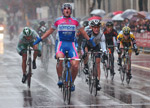 There can't be good weather every day of the race. Are there rain delays?
There can't be good weather every day of the race. Are there rain delays?
Nope. Riders race in any and all weather conditions. From blistering heat waves to biblical deluges, there are few meteorological events that will get in the peloton's way (rarely stages will be altered in cases of extreme weather). Some of cycling's most legendary escapades occurred in inclement weather. Lance Armstrong won the Tour stage to Sestrière in a downpour, Bernard Hinault took Liège-Bastogne-Liège in a driving snowstorm and Andy Hampsten, the only American ever to win the Giro d'Italia, took control of the race during an epic blizzard in the mountains of Italy.
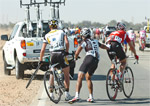 That guy just gave a teammate his bike! What's up with that?
That guy just gave a teammate his bike! What's up with that?
The Tour is a team event and each team is comprised of nine riders. Within a team, there are one or two riders who hope to achieve a high overall finish. Most teams also have a sprint specialist trying for stage wins during the flat days. The remaining five or six riders are considered domestiques or helpers, and they do just that, as their job description includes carrying extra food and water, and chasing down breakaway groups. Amazingly, a domestique is even expected to give up his bicycle to a team leader should he have a mechanical issue.
Why is that rider talking into his shirt?
All racers carry miniature radios in their back pockets that allow them to talk with their teammates and team director while rolling down the road. The earpieces of these high-tech intercoms look like spy paraphernalia. The microphones stay hidden, clipped to the inside of the rider's collar. Therefore, when you see a rider "speaking into his jersey" he is actually using his microphone to talk with someone on his team. This on-the-fly communication is of great value, as it lets riders who are scattered throughout the pack plan race strategy and ride accordingly.
 Don't they get hungry?
Don't they get hungry?
Yes, they get very hungry! Nutrition is so important to racing success that some say the Tour is partially won at the dinner table, as riders who successfully fulfill their daily need of 7,000 to 10,000 calories are more assured of optimum results. While actually racing, riders mostly consume liquid sugar in the form of sports gels and drinks (Coke is a favorite). It's also no surprise to see mini ham sandwiches, candy bars, and pastries peeking out of jersey pockets. At dinner, it's a full-on feeding frenzy: pasta, potatoes, rice, cereal, bread, fruits, vegetables, eggs, meat and yogurt is all fair game and consumed with gusto.
When do they go to the bathroom?
Ah, it's a question that someone had to ask. Many times the pack will make a group decision and stop for a quick "natural break" at the side of the road. Riders will also urinate off the bike, usually while coasting on lengthy downhills. If a rider really has to go and there's no downhill near, a teammate may push the bladder-challenged racer along as he relieves himself... hopefully while the TV cameras are not watching!
